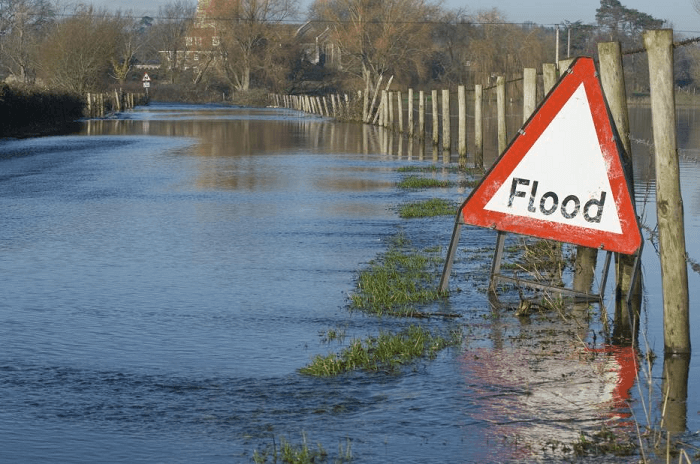Flood DefinitionA flood is a natural disaster when water overflows from its normal course and inundates dry land. This excess water can come from many sources, including heavy rainfall, melting snow and ice, coastal storms, and overflowing rivers and lakes. Floods can happen anywhere but are most common in low-lying areas near rivers, lakes, and coastlines. 
Floods can have devastating consequences for people and their property. They can cause widespread damage to buildings, roads, and other infrastructure, disrupt transportation and communication systems and lead to loss of life and displacement of communities. Even small floods can have a significant impact, as they can cause erosion, landslides, and damage to soil fertility. In addition, floods can have long-term effects on communities, such as the increased risk of disease, loss of economic livelihoods, and social and psychological trauma. There are several types of floods, each with unique characteristics and causes. One common type of flood is a flash flood, which occurs when heavy rainfall accumulates rapidly and overwhelms drainage systems. Flash floods can happen in any region but are most common in mountainous and urban areas. Another type of flood is a riverine flood when a river overflows its banks and inundates adjacent land. Riverine floods can be caused by heavy rainfall, snowmelt, or dam and levee failures. Coastal floods, on the other hand, occur when storm surges and high tides cause seawater to inundate coastal areas. Coastal floods can be particularly devastating, as they can cause erosion, damage to infrastructure, and loss of life. Floods are often classified based on their likelihood of occurrence and the degree of damage they can cause. A 100-year flood, for example, is a flood that has a 1% chance of occurring in any given year. This does not mean that the flood will only occur once every 100 years, but rather that it has a 1% chance of occurring in any given year. A 500-year flood, by contrast, has a 0.2% chance of occurring in any given year. These classifications are important for assessing flood risk and determining flood insurance requirements in different regions. Floods can be mitigated through various measures, including structural and non-structural approaches. Structural measures include the construction of levees, dams, and other flood control structures, while non-structural measures include floodplain zoning, early warning systems, and education campaigns. These measures can reduce the likelihood and severity of floods and help communities to prepare for and respond to flood events. Causes of FloodVarious natural and human factors, including heavy rainfall, snowmelt, coastal storms, river or dam failures, and urbanization, can cause floods. Understanding the causes of floods is important for assessing flood risk and developing effective flood management strategies. One of the most common causes of floods is heavy rainfall. Water can overflow and inundate adjacent land when precipitation accumulates rapidly and exceeds the capacity of rivers, lakes, and drainage systems. This can happen in any region, but it is most common in areas with high precipitation rates or regions with frequent storms. Climate change and global warming are also exacerbating the effects of heavy rainfall, leading to more frequent and intense weather events. Snowmelt is another common cause of floods, particularly in mountainous regions or areas with significant snow accumulation. When temperatures rise, the snow melts and runs into rivers and lakes, increasing water levels and potentially causing flooding. This can be especially dangerous if the snowmelt is combined with heavy rainfall, as it can amplify the effects of the flood and make it more severe. Coastal storms, including hurricanes and tropical storms, can cause coastal flooding. Storm surges and high tides can push seawater onto land, causing flooding and erosion. This can be particularly devastating in regions with low-lying coastal areas, as these areas are more vulnerable to the effects of coastal flooding. Human activities can also contribute to the causes of floods. Urbanization, for example, can increase the risk of floods by reducing natural areas that absorb water and increasing impervious surfaces that prevent water from infiltrating the ground. Urban areas also have complex drainage systems that can become overwhelmed during heavy rainfall or snowmelt, leading to flooding. Another human-related factor is river and dam failures. When dams or levees fail, water can be released rapidly and inundate adjacent areas. This can be caused by natural disasters, such as earthquakes, or by inadequate maintenance or design of the structures. Deforestation and soil degradation can also contribute to the causes of floods. When natural areas are destroyed, the soil becomes less able to absorb water, leading to increased runoff and erosion. This can increase the likelihood and severity of floods in downstream areas. Prevention MethodsFlooding is a natural disaster due to heavy rainfall, rapid melting of snow, or coastal storm surges. It can happen suddenly and without warning, leading to catastrophic consequences such as loss of life, property damage, and destruction of infrastructure. Therefore, it is crucial to be prepared and know the safety measures to follow during flooding.
ConclusionFlooding is a natural disaster that can be extremely dangerous if you are unprepared. Putting your and your family's safety first is essential during a flood. Be prepared in advance with an emergency plan, and follow the instructions of local authorities. It is essential to stay informed, follow evacuation orders, avoid contact with floodwater, and move to higher ground. If you cannot evacuate, don't use open flames and follow the authorities' instructions. Following these safety measures can minimize the risks of injury or death during a flood.
Next TopicFood Definition
|
 For Videos Join Our Youtube Channel: Join Now
For Videos Join Our Youtube Channel: Join Now
Feedback
- Send your Feedback to [email protected]
Help Others, Please Share










